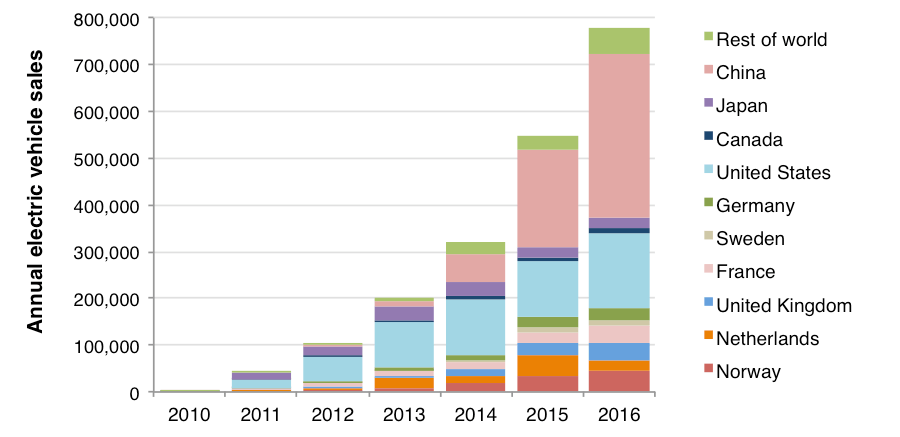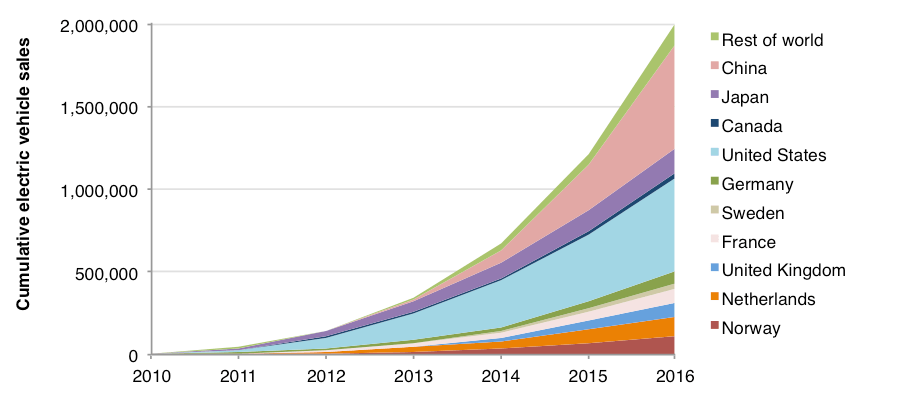Blog
The rise of electric vehicles: The second million
In late 2015, we heralded the first million electric vehicles taking to the road around the world. In January 2017, cumulative global electric vehicles sales already reached the second million. As milestones go, there’s nothing quite like the first, but the second can be quite sweet too, with the added experience and maturity. So, with this latest milestone, what do we now know about where and how the electric car market is developing?
Annual growth. Well, for one thing, the market is still heating up. Thanks to our friends at EV Sales, we’ve been able to track sales nearly in real time. We’ve seen steady annual growth in global electric car sales over the past 3 years (~60%, 70%, and 40%, in 2014, 2015, and 2016, respectively) to reach about 770,000 sales in 2016. The annual growth varies across world markets. The largest 2016 growth among major auto markets was in China, which saw over 70% growth to about 350,000 electric vehicle sales. Canada, Sweden, and France each had 50%–70% growth in 2016. Norway, the United States, and the United Kingdom had around 30% electric car sales growth in 2016. In its first half year with new consumer financial incentives, the German electric market gained about 12% in 2016. But it wasn’t all growth in every market in 2016, as markets in the Netherlands (–45%) and Japan (–15%) lost ground.
Market size. As sales keep increasing, the largest electric vehicle markets are becoming clearer. The countries with the most electric vehicle sales, through 2016, are China (~630,000), the United States (~560,000), Japan (~140,000), Norway (~114,000), and the Netherlands (~111,000). It appears that the markets next in line in 2017 to enter the rank of these markets with over 100,000 electric vehicles are the United Kingdom, France, and Germany, each with 75,000 to 90,000 cumulative electric vehicles on their roads through the end of 2016. The Sweden and Canada markets are around 30,000 electric vehicles each. This growing global market means that global competition and battery production are on the rise, which means electric car prices will keep dropping.
Electric sales shares. Of course it’s not only market size that matters. One of the most intriguing metrics to gauge which markets are hottest is the share of new vehicles that are plug-ins. Norway remains the perennial world leader, now with a 29% share in 2016. The Netherlands, with a very hot December market (preceding a major drop in plug-in hybrid incentives for 2017), remained second with a 6% electric share. Iceland, a much smaller market, came in with a very strong 5% share in 2016. Sweden’s solid market growth made for a 4% electric share. After that, Switzerland and France came in at around 2% electric, and most other markets are still hovering somewhere around 1%. Perhaps more intriguing is that there are hot markets within all of these regions with much higher electric vehicle uptake. For example, our ongoing local-level analysis shows that markets like San Jose, San Francisco, Beijing, Shanghai, Shenzhen, Amsterdam, Utrecht, Stockholm, and Copenhagen had 4%–11% electric shares.
Underlying market drivers. Each of the above markets holds important lessons about the many factors that are needed to grow the market. Examining the electric car hot spots, we start to see the keys that are helping to unlock the market, including sustained well-designed national incentives and a strong mix of local policy, charging infrastructure, and utility support as in select U.S. cities. Beyond policy, strategic education and awareness campaigns like the UK’s Go Ultra Low or the emerging campaign in the Northeast U.S. are important, as are having sufficient electric car availability and automaker marketing efforts in local markets. We’ve seen how effective local campaigns and network effects can be in the many California cities that have 8 to 25 times the U.S. average electric car uptake. Surely a couple billion dollars from the Volkswagen settlement can further support all of the U.S. activities (VW is taking in ideas to Electrify America . . .). The ZEV Alliance continues to accelerate learning from all these market developments and government efforts to spur electric vehicle uptake.
Will this trend toward electric continue? It sure seems so, and it might even keep gaining steam. It’s getting especially hard to track the flurry of city actions—including carrots like consumer incentives and perks, and sticks like regulations and restrictions—to move beyond combustion. London is moving toward an Ultra Low Emission Zone, which progressively allows electric vehicles greater access to the city center. Paris, Madrid, Athens, and Mexico City are banning diesel vehicles. Oslo is trying out temporary bans on diesel cars, as Norway seeks to phase out fossil-fuel vehicles. San Francisco, Los Angeles, Seattle, and Portland are working on a bulk purchase of 24,000 electric cars. The leading China markets of Shanghai and Beijing use vehicle-licensing policies to curb vehicle registrations, and then exempt electric vehicles from the licensing requirements to spur sales and help clean their dirty air.
As California regulatory chair Mary Nichols points out, there’s now agreement that the world is going electric; it’s just a matter of how quickly we can get there.


